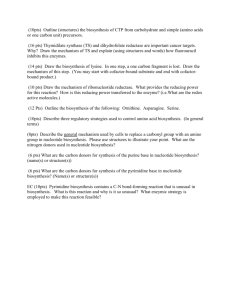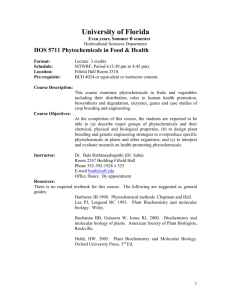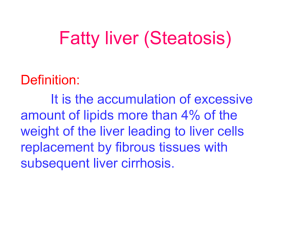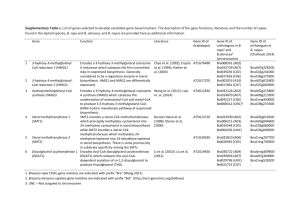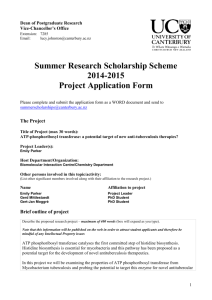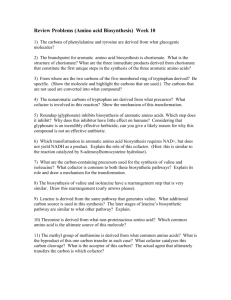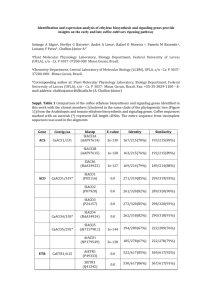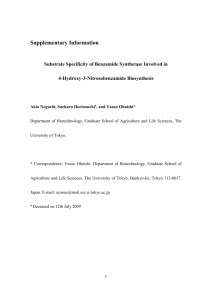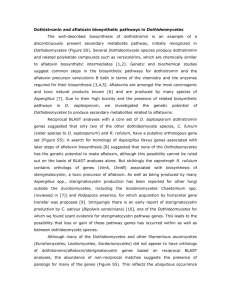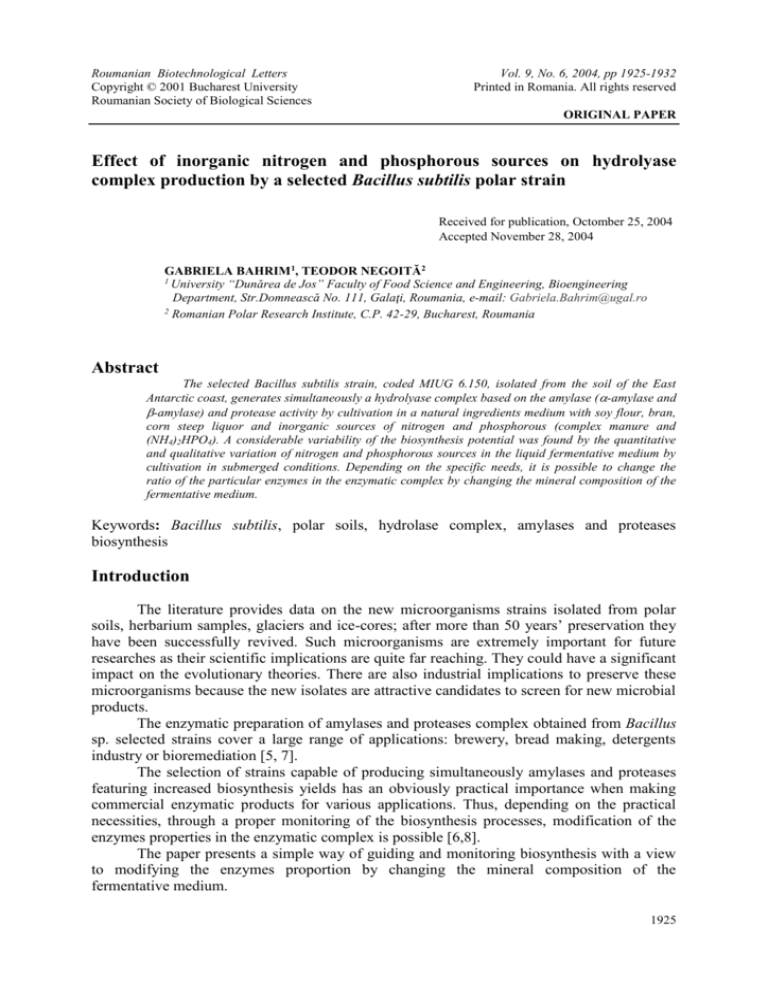
Roumanian Biotechnological Letters
Copyright © 2001 Bucharest University
Roumanian Society of Biological Sciences
Vol. 9, No. 6, 2004, pp 1925-1932
Printed in Romania. All rights reserved
ORIGINAL PAPER
Effect of inorganic nitrogen and phosphorous sources on hydrolyase
complex production by a selected Bacillus subtilis polar strain
Received for publication, Octomber 25, 2004
Accepted November 28, 2004
GABRIELA BAHRIM1, TEODOR NEGOITĂ2
1
University “Dunărea de Jos” Faculty of Food Science and Engineering, Bioengineering
Department, Str.Domnească No. 111, Galaţi, Roumania, e-mail: Gabriela.Bahrim@ugal.ro
2
Romanian Polar Research Institute, C.P. 42-29, Bucharest, Roumania
Abstract
The selected Bacillus subtilis strain, coded MIUG 6.150, isolated from the soil of the East
Antarctic coast, generates simultaneously a hydrolyase complex based on the amylase ( -amylase and
-amylase) and protease activity by cultivation in a natural ingredients medium with soy flour, bran,
corn steep liquor and inorganic sources of nitrogen and phosphorous (complex manure and
(NH4)2HPO4). A considerable variability of the biosynthesis potential was found by the quantitative
and qualitative variation of nitrogen and phosphorous sources in the liquid fermentative medium by
cultivation in submerged conditions. Depending on the specific needs, it is possible to change the
ratio of the particular enzymes in the enzymatic complex by changing the mineral composition of the
fermentative medium.
Keywords: Bacillus subtilis, polar soils, hydrolase complex, amylases and proteases
biosynthesis
Introduction
The literature provides data on the new microorganisms strains isolated from polar
soils, herbarium samples, glaciers and ice-cores; after more than 50 years’ preservation they
have been successfully revived. Such microorganisms are extremely important for future
researches as their scientific implications are quite far reaching. They could have a significant
impact on the evolutionary theories. There are also industrial implications to preserve these
microorganisms because the new isolates are attractive candidates to screen for new microbial
products.
The enzymatic preparation of amylases and proteases complex obtained from Bacillus
sp. selected strains cover a large range of applications: brewery, bread making, detergents
industry or bioremediation [5, 7].
The selection of strains capable of producing simultaneously amylases and proteases
featuring increased biosynthesis yields has an obviously practical importance when making
commercial enzymatic products for various applications. Thus, depending on the practical
necessities, through a proper monitoring of the biosynthesis processes, modification of the
enzymes properties in the enzymatic complex is possible [6,8].
The paper presents a simple way of guiding and monitoring biosynthesis with a view
to modifying the enzymes proportion by changing the mineral composition of the
fermentative medium.
1925
GABRIELA BAHRIM, TEODOR NEGOITĂ
Material and Methods
Microorganisms, media and cultural conditions. The Bacillus subtilis MIUG 6.150
strain was isolated, in 1999, from polar soil, the area Larsemann Hills Progress Station, East
Antarctic coast. The culture belongs to the Microbiology Laboratory of Galati University
(Collection of Microorganims acronym MIUG) and is preserved by adsorption of the spores
on sterile sand grains [2].
To establish the influence of the medium composition on the enzymatic complex
production we start from a basal medium containing bran, soy flour, corn steep liquor and
CaCl2 [3]. A number of nine variants of fermentative media were conceived and examined to
quantitatively check the optimal composition of the inorganic sources of nitrogen and
phosphorous (complex manure and (NH4)2HPO4).
To eliminate other influencing factors use was made of the vegetative inoculum
obtained by pure culture cell transfer in a liquid nutrient broth after cultivation to 24-28 hrs on
slant agar medium. After 24 hours’ cultivation in submerged conditions, 2% cell suspension
was used to inoculate the fermentative medium variants. Cultivation for enzymes biosynthesis
was performed in submerged system, in Erlenmeyer vessels of 500 ml, with 150 ml liquid
medium. Cultivation took place 96 hours, at 32ºC, on a rotary shaker at 200 rot/min.
Evaluation of the hydrolase complex activities. The following enzymatic activities
were examined in the liquid culture, after biomass separation at 9000 rot/min, for 10 minutes
[1]:
- -amylase activity by using a adapted method (MIUG method) based to a selective
distinction of the hydrolysis products in 0.1 N Lugol solution. One -amylase unit
according to this method stands for the amount of enzyme which generates a 0.05
decrease in the optical density, for 1 minute, as measured OD at 610 nm, of the
colored iodine-starch colored complex, into a 1% starch solution, at pH 7.0 and 70ºC;
- -amylase activity by Merck method. One -amylase unit represents the amount of
maltose (in mg) release from 1% starch as substrate, by 1 ml enzymatic liquid at 55ºC,
pH 6.0, for one minute;
- global protease activity by Anson modified method. One Anson unit stands for the
amount of enzyme which, under the analytical specified conditions (2 % casein as
substrate, pH = 8.0; for 15 min, at 30°C) hydrolyzes the casein at a speed that
facilitates release, in one minute, the hydrolysis products soluble in the trichloroacetic
acid; this provides coloration equivalent, measured by spectrophotometry at OD 570
nm, to that of one mole of tyrosine, in the presence of the Folin-Ciocâlteau reagent.
Results and discussions
It is well known that bacterial proteases and amylases are extracellular enzymes which
synthesis depends on the environment conditions. As inductors, in addition to the substrate,
the metabolism end products can be effective too [4].
A repression of the proteases biosynthesis process can be caused by the fastmetabolized carbon sources, which generates the catabolism repression and the presence of
amino acids and ammonia.
Another particular specific to the extracellular proteases is the existence of a limited
period, at the end of the exponential phase and the beginning of the stationary phase, when
biosynthesis is produced. Due to these particulars, the designing of the biotechnology to
1926
Roum. Biotechnol. Lett., Vol. 9, No. 6, 1925-1932 (2004)
Effect of inorganic nitrogen and phosphorous sources on hydrolyase complex production
by a selected Bacillus subtilis polar strain
produce microbial enzymes is based on the physiology of the producing agent and its
behavior depending on the medium composition and the cultivation conditions.
The experiment is carried out to provide information on two independent variables:
complex manure concentration and the concentration of (NH4)2HPO4 on the biosynthesis yield
of the enzymes in the amylase-protease complex (-amylase, -amylase and protease). The
computation program used for optimization purpose is the Table Curve 3D (Jandel Scientific
software).
Starting from the composition of a basic medium found optimum for the biosynthesis
of the three enzymes in the enzymatic complex a number of nine variants of culture media
was develop by varying + and – of the two independent variables, the concentration of
complex manure and concentration of (NH4)2HPO4 chosen as factors to study (Table 1 and
Table 2).
Table 1. The composition of the basal medium and the level of the independent variable variations
Composition of the basal medium
Nutritive sources
Concentrations, g%
- Bran
- Soy flour
- Corn steep liquor
- CaCl2·6H2O
5
1,2
2,4
0,2
Symbol
Independent variables
Levels of variation
-1
- Complex manure*, g %
0
1
0,5
0
1,5
0,5
0
1,5
X
- (NH4)2HPO4 , g%
Y
* 16% N2, 45 % P2O5
Cultivating the selected strain Bacillus subtilis MIUG 6.150 on the nine culture media
resulted by varying the two independent variables (complex manure and ammonia phosphate)
and evaluating the enzymatic potential of the enzymes in the amylase-protease complex, after
96 hours’ submerged cultivation the following correlations were obtained:
Variants of
fermentative
media
1
2
3
4
5
6
7
Table 2. Experimental design of independent variables variation
Level of variation for
Concentration of inorganic nitrogen
independent variables
and phosphorus sources, g%
X
Y
Complex manure
(NH4)2HPO4
+1
-1
+1
-1
0
0
+1
-1
+1
+1
-1
+1
-1
0
1.5
0.5
1.5
0.5
0
0
1.5
Roum. Biotechnol. Lett., Vol. 9, No. 6, 1925-1932 (2004)
0.5
1.5
1.5
0.5
1.5
0.5
0
1927
GABRIELA BAHRIM, TEODOR NEGOITĂ
1. Variation of the -amylase activity. Correlation of the amylase activity and the
variation of the inorganic sources of nitrogen and phosphorous meet the polynomial equation
(z = a + bx + cy + dx2 + ey2 + fxy; were z is the response, i.e. enzymatic activity;
UA×ml-1 enzyme×min-1) chosen and provides the response surface which varies
according to the diagram in Figure 1. The assumptions regarding the models consistency
2+ey
2+fxy
were verified through the tests t Rank
and4 FEqnboth
calculated
for
a significance level of = 0.05
301 z=a+bx+cy+dx
r =0.63649921 DF Adj r =-0.45400314 FitStdErr=3.2297074 Fstat=1.0506154
(Table 3).
a=15.413163 b=-5.4799116 c=-0.85091156
2
2
20
20
17.5
17.5
15
Z
15
12.5
12.5
10
10
7.5
7.5
5
0.25
0.5
Y
0.75
1
1.25
1.5 1.5
1.2
5
0.7
5
1
0.5
0.2
5
X
5
Activitate apha-amilazica, UAxcmE-3 enz.x min.E-1
d=1.1073333 e=-2.6906667 f =3.4283673
Z
Figure 1. Quantitative and correlative effects of the nitrogen and phosphorous inorganic sources on
the bacterial -amylase biosynthesis
For a mean square deviation equal to r2 = 0.6364 only 63.64% of the experiments fit
into the model. From the analysis of the regression equation coefficients the - amylase
biosynthesis yield seems to be strongly influenced by the other components of the
fermentative medium (the coefficient takes a very high value); as regards the variables tested,
their absence leads to new max enzyme activities. Also o positive influence on the
biosynthesis can be that of the interaction between the two independent variables. Not all the
regression coefficients are significant, so in order to establish a real model, only the
coefficients falling within the confidence range will be used.
Table 3. Estimation of the correlation coefficients according to the - amylase biosynthesis model
Regresion coeficients
Value
95% Confidence limits
min.
max.
a
15.4131
2.7034
5.7012
6.8733
23.9530
Pt
0.0107
b
c
d
e
f
-5.4799
-0.8509
1.1073
-2.6906
3.4283
7.7337
7.7337
4.6513
4.6513
2.7683
-0.7085
-0.1100
0.2380
-0.5784
1.2384
-29.9095
-25.2805
-13.5854
-17.3834
-5.3163
18.9497
23.5787
15.8000
12.0020
12.1730
0.5296
0.9193
0.8271
0.6035
0.3036
Std. Erorr
t*
F
Statistic
P>F
1.0506
0.5173
* the values of the STUDENT test for the regression coefficients
1928
Roum. Biotechnol. Lett., Vol. 9, No. 6, 1925-1932 (2004)
Effect of inorganic nitrogen and phosphorous sources on hydrolyase complex production
by a selected Bacillus subtilis polar strain
2. Variation of the -amylase activity. Under identical analysis conditions, the
response surface reflecting the correlation between the quantitative variation of the nitrogen
and phosphorous inorganic coefficient in the fermentative medium composition and the amylase activity is illustrated in Fig. 2. The values2 of
the regression and correlation
Rank 4 Eqn 301 z=a+bx+cy+dx +ey 2+fxy
2
2
coefficients, their significance
and
the
confidence
intervals
are
all presented
in Table 4.
r =0.765404 53 DF Adj r =0.061618 132 FitStdErr=0.32 488865 Fstat=1.95759
42
2.5
2.5
2
2
Z
1.5
Activitate beta-amilazica, UA x cmE-3xmin.E-1
a=1.7971701 b=-1.280421 8 c=0.6 6713379
d=0.40533 333 e=-0.62711 111 f=0.3 6263265
1.5 Z
1
1
0.5
0.25
0.5
Y
0.5
0.75
1
1.25
1.5 1.5
1.2
5
0.7
5
1
0.5
0.2
5
X
Fig. 2. The effect of the nitrogen and phosphorous inorganic sources on
the bacterial -amylase biosynthesis
The regression equation standing for the variation of the extracellular -amylase
biosynthesis yield depending on the independent variables (complex manure concentration
and ammonium phosphate) is valid for 76.64 % of the experiments.
Table 4. Statistical parameters according to the -amylase biosynthesis model
Regresion coeficients
Value
t*
95% Confidence limits
min.
max.
a
1.7971
0.2719
6.6083
0.9381
2.6562
Pt
0.0070
b
c
d
e
f
-1.2804
0.6671
0.4053
-0.6271
0.3626
0.7779
0.7779
0.4678
0.4678
0.2784
-1.6458
0.8575
0.8662
-1.3402
1.3022
-3.7378
-1.7903
-1.0726
-2.1051
-0.5170
1.1770
3.1246
1.8833
0.8508
1.2422
0.1983
0.4541
0.4500
0.2726
0.2838
Std. Erorr
F
Statistic
P>F
1.95759
0.30787
The following conclusions become obvious from the analysis of the polynomial
equation coefficients:
- the max. value of the coefficient a confirms the existence of other independent
variables which influence the -amylase biosynthesis yield;
Roum. Biotechnol. Lett., Vol. 9, No. 6, 1925-1932 (2004)
1929
GABRIELA BAHRIM, TEODOR NEGOITĂ
- the presence of ammonia phosphate positively influence the -amylase biosynthesis
yield, as confirmed by the relation c > b;
- the max values of the -amylase biosynthesis yield are recorded in the absence of the
complex manure and at concentrations of 0.5 % ammonium phosphate.
12
Z
12
11
11
10
10
9
9
8
8
7
7
6
1.25
6
5
1.2
1
5
0.7
Y
0.5
5
0.2
0 0
0.5
0.25
1
0.75
Activitate proteazica, UAxcmE-3xmin.E-1
3. Variation of the protease activity. To investigate the effect of the two independent
variables on the alkaline protease activity the gross preparation enzymatic activity of
hydrolase enzymatic complex was studied.
The response surface according to the polynomial
Rank 3 Eqn 301 z=a+bx+cy+dx 2+ey 2+fxy
Adj r2=-0.04058956
FitStdErr=1.6298507
Fstat=1.7063849
equation varied as shown inr2=0.73985261
Fig. 3.DFThe
polynomial
equation
chosen meet in 73.98 %
a=8.783434 b=-4.6366066 c=2.786649
experiments to values of the regression and
correlation
coefficients illustrated in Table 5.
d=3.8142444
e=-2.5696 f =-0.40687347
Z
X
Figure 3. Correlated effect of the nitrogen and phosphate mineral sources on the bacterial protease
accumulation
Table 5. Estimation of the correlation coefficients and the confidence intervals for the model
of bacterial protease biosynthesis
Regresion coeficients
Value
t*
95% Confidence limits
min.
max.
a
8.7834
1.3643
6.4381
4.4738
13.0930
Pt
0.0076
b
c
d
e
f
-4.6366
2.7866
3.8142
-2.5696
-0.4068
3.9028
3.9028
2.3473
2.3473
1.3970
-1.1881
0.7141
1.6249
-1.0947
-0.2912
-16.9648
-9.5416
-3.6003
-9.9842
-4.8198
7.6916
15.1149
11.2288
4.8449
4.0060
0.3203
0.5267
0.2026
0.3536
0.7898
Std. Erorr
F
Statistic
P>F
1.70638
0.35011
From this regression equation too it can be seen the existence of other independent
variables which have a considerable effect on the biosynthesis yield (coefficient a takes a very
high value as compared with the other coefficients).
1930
Roum. Biotechnol. Lett., Vol. 9, No. 6, 1925-1932 (2004)
Effect of inorganic nitrogen and phosphorous sources on hydrolyase complex production
by a selected Bacillus subtilis polar strain
The max protease activity of the gross preparation can be reached with approx.1.5 %
complex manure and 0.42 % ammonia phosphate. The ammonia phosphate has influence on
the alkaline protease biosynthesis which is also certified by the values c > b. The complex
manure is a condition for the alkaline protease biosynthesis through a nonlinear correlation its
effect being underlined by the high value taken by the coefficient d which is almost equal to
that of coefficient.
CONCLUSIONS
1. According to the response surface methodology the effect of some nutrients as
inorganic sources of nitrogen and phosphorous, complex manure and ammonium
phosphate on the enzyme biosynthesis yield in the amylase-protease complex obtained
with the Bacillus subtilis selected strain MIUG 6.150 was studied.
2. The max yield of the -amylase biosynthesis is reported in the absence of both
mineral sources.
3. In the case of -amylase, max biosynthesis yields are obtained on media without
complex manure and 0.5% ammonia phosphate.
4. The biosynthesis of the bacterial protease is significantly affected by the complex
manure, max biosynthesis yield being obtained at a concentration of 1.5% in the
medium, which is maximum for these experiments. The presence of the ammonia
phosphate is favorable in this case, as the concentrations of 0.42 % together with 1.5
% complex manure makes possible for max protease yield to be achieved.
5. The study ensures the control and handling of the enzyme biosynthesis in the amylaseprotease complex by using a base medium of natural ingredients and stimulating the
biosynthesis of the complex enzymes using mineral sources of nitrogen and
phosphorous.
6. The research has demonstrated that biosynthesis of the three enzymes is also
influenced by other components in the fermentative medium which effect needs
further studies and optimization.
Acknowledgements
This work was supported by the World Bank Grant C138
References
1. G. BAHRIM, A. NICOLAU, Biotehnologia preparatelor enzimatice. Tehnici si analize de
laborator. Ed. Academica Galati (2002)
2. G. BAHRIM, T. NEGOIŢĂ, 3rd Annual Meeting of Polar Section of the Czech Geographical
Society ACADEMIC AND UNIVERSITY CENTRUM - Nove Hrady near Trebon, Czech
Republic (2002)
3. V. DAN, G. BAHRIM, A. NICOLAU, Roumanian Patent No 14150 (1999)
4. R. MULLER, Enzyme and Microbial Technology, 27, 337–344 (2000)
5. T. GODFREY, J. REICHELT, Industrial Enzymology the Application of Enzymes in Industry.
Nature Press. New York (1983)
6. F.G. HEINEKEN, F.G. OCONNER, J. Gen Microbiol, 73, 35 (1972)
Roum. Biotechnol. Lett., Vol. 9, No. 6, 1925-1932 (2004)
1931
GABRIELA BAHRIM, TEODOR NEGOITĂ
7. F.G. PRIEST, Products and Applications In: Bacillus Biotechnology. Hand Book 2, Plenum.
New York-London (1989)
8. Y. YONEDA, B. MARVA, J. Bacteriol., 124, 48-54 (1975)
1932
Roum. Biotechnol. Lett., Vol. 9, No. 6, 1925-1932 (2004)

